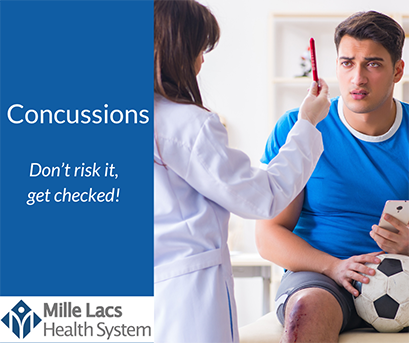Be careful with concussions
September 15, 2023
It’s important to encourage a healthy lifestyle with our youth through physical activity either in team sports or activities at home. However, with being more active, accidents can happen, and one of the more common “sports” related injuries is concussion.
A concussion is a mild form of traumatic brain injury (TBI) caused by a bump, blow, or jolt to the head. Concussions can also occur from a fall, or a blow to the body that causes the head to move rapidly back and forth.
According to the CDC, nearly half of the emergency room visits by children each year are due to a traumatic brain injury sustained while participating in a contact sport. Some of the sports particularly susceptible to concussions include: football, soccer, lacrosse, ice hockey, basketball, wrestling, and gymnastics.
Some of the more common concussion symptoms to look for immediately after someone has sustained an injury include: loss of consciousness, balance problems, delayed responses, vomiting, one pupil larger than the other, and a glazed over expression.
Concussion symptoms can vary from one person to another and may not appear until several days after the incident. Some of the other symptoms to watch for later include: headaches, nausea, sensitivity to light or sound, irritability/nervousness, blurry or double vision, excessive sleepiness, or difficulty falling asleep.
The National Safety Council (NSC) reports that 10% of all contact-sports athletes sustain concussions yearly. It’s also been found that an athlete who sustains a concussion, is four to six times more likely to sustain a second concussion. Each additional concussion often leads to longer recovery times, and can lead to long-term lasting effects.
Regardless of how minor it may seem, a head injury should always be checked out by a medical professional. Various tests and cognitive assessments can be done to evaluate the patient’s condition, and provide a recommended recovery regimen.
According to the Brain Injury Association of America, half of people who suspect they have a concussion never get it checked out. Don’t risk it, get checked!
In most cases, concussion recovery takes about seven to ten days. However, if the patient doesn’t get enough rest and follow the doctor’s orders it can take longer. A complication that can occur following a concussion is second-impact syndrome. It arises if a second concussion occurs before the first one fully heals. Second-impact syndrome can lead to fatal brain swelling. The risk of this complication is much higher in those who play high impact sports. This is why it’s vital to always fully recover from a concussion prior to returning to normal activities.
If you are concerned about a possible concussion, visit Mille Lacs Health System Urgent Care in Onamia, open seven days a week, 8:00 a.m. – 8:00 p.m., or the Emergency Department which is open 24/7.
